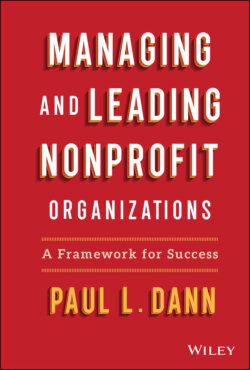Читать книгу Managing and Leading Nonprofit Organizations - Paul L. Dann - Страница 17
Opportunity and Engagement
ОглавлениеMy own research in leadership development discussed in depth in Chapter 5 shows that leadership skills and abilities will grow when opportunities are present to take on leadership responsibilities. Actively pursuing opportunities for developing your leadership practice aligns closely with your engagement with the organization and taken together they can be a powerful source for leadership development. Given this, use your practice perspectives to be on the hunt for opportunities to advance your leadership skills. On any given day, if you avail yourself, you will find there are multiple instances that can serve as an opportunity to develop your leadership skills. This can be something as simple as volunteering to serve on a committee, being willing to take on a specific responsibility for the team such as organizing an event, agreeing to take minutes, offering to pursue a fundraiser, or any number of activities, including representing the organization with external stakeholders.
If you are willing to step up and take it on, then you will quickly see that your fellow team members—including your supervisors—no matter the level, will begin to gravitate toward you and think of you as a go‐to person for activities that can lend themselves to additional leadership responsibility and, more important, your capacity to develop as a leader. Actively pursuing opportunities to develop your leadership skills will provide you with invaluable experience so that you can practice and refine your leadership skills.
For example, I can think of a newly minted entry‐level leader within a nonprofit multiservice agency who was seen volunteering for any number of activities. First, he offered to keep track of his program's monthly vehicle safety checklist. From there his director asked him if he wanted to serve as the safety coordinator, representing his program for the agency's corporate safety committee. Soon the committee discovered that he had graphic design skills and he began churning out a wonderful safety committee newsletter—while along the way being promoted to assistant director. It was clear that he not only possessed leadership skills but was actively refining them while building his reputation as a go‐to person. He is on a journey, and it will be interesting to see where the journey takes him.
Pursuing opportunity and working to be fully engaged not only benefits the individual, but also the entire team. In my formal leadership role, I know that creating multiple opportunities for employees to be engaged and to develop their own leadership capabilities not only helps them learn and grow but also benefits the organization. An organization that has multiple opportunities for employees to develop and express leadership is an organization that is vibrant and dynamic.
Nonprofit agencies, when organized well, can help to ensure that there are multiple opportunities for employees to become engaged in developing their leadership capabilities. Clearly there are the traditional notions of leadership training programs which in and of themselves have a positive impact, and then there are a multitude of other strategies that can help to build your organization's culture of leadership development. As mentioned, committees are an easy way to help people develop their leadership capacity. In particular, ad hoc committees that are working to address a particular project can be useful as a strategy to connect employees to a level of leadership practice. There are other structural strategies as well. For example, how the organization pursues its continuous quality improvement (CQI) practices can help or hinder the development of leadership practice. Is the effort pursued by a single department or employee or is there cross‐organization participation for employees at various levels within the agency? Providing opportunities for various parts of the organization to work together on functions beyond the individual's day‐to‐day responsibilities makes it possible for individuals to step up and take responsibility that not only benefits the organization but also helps the employee build their own leadership practice.
For example, rather than simply relying on a quality improvement director, you might develop a peer‐review process that engages interdisciplinary team members from across the organization to share in continuous quality improvement visits, CQI goals, and objectives as well as practices. In this way there are multiple opportunities for employee engagement and leadership development that are built into the organization's practices.
Strategies of this type can be pursued across the organization, covering various agency functions. From continuous quality improvement practices to employee training and development to information technology to events planning, the use of systems that provide the framework for employees of the organization to pursue opportunities to develop their leadership capacity are many. As an individual, watch for these opportunities; as a leader within an organization, strive to optimize the number that are available, knowing that done well these opportunities will build leadership practice across the organization.
